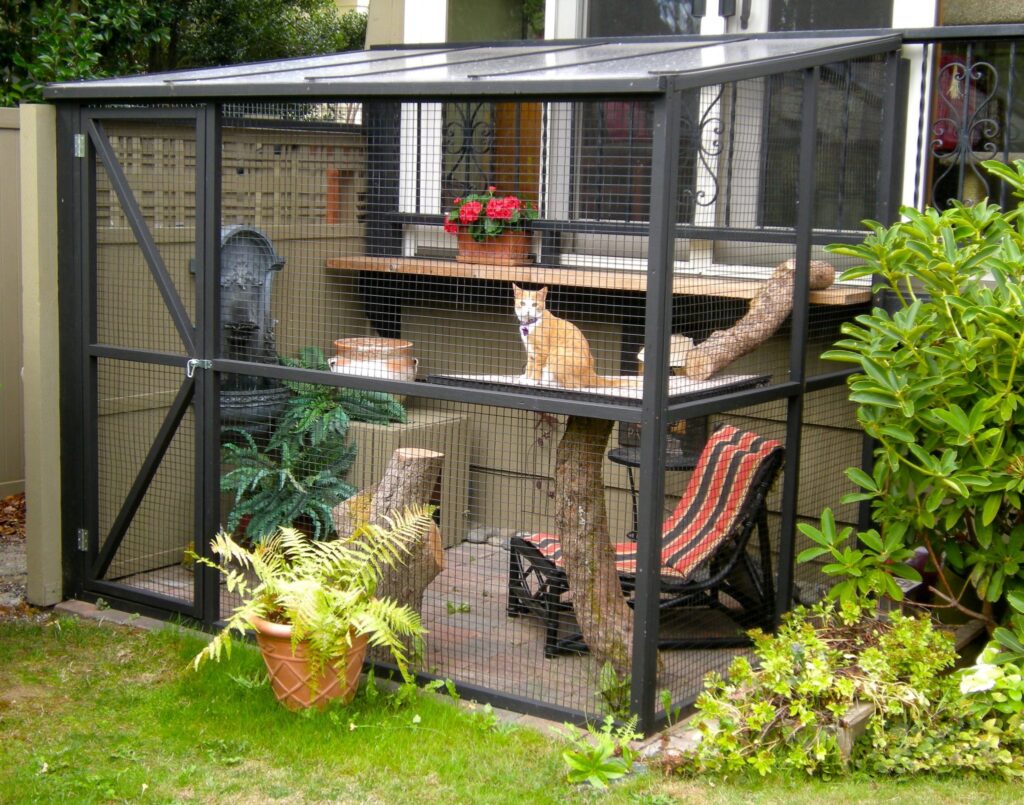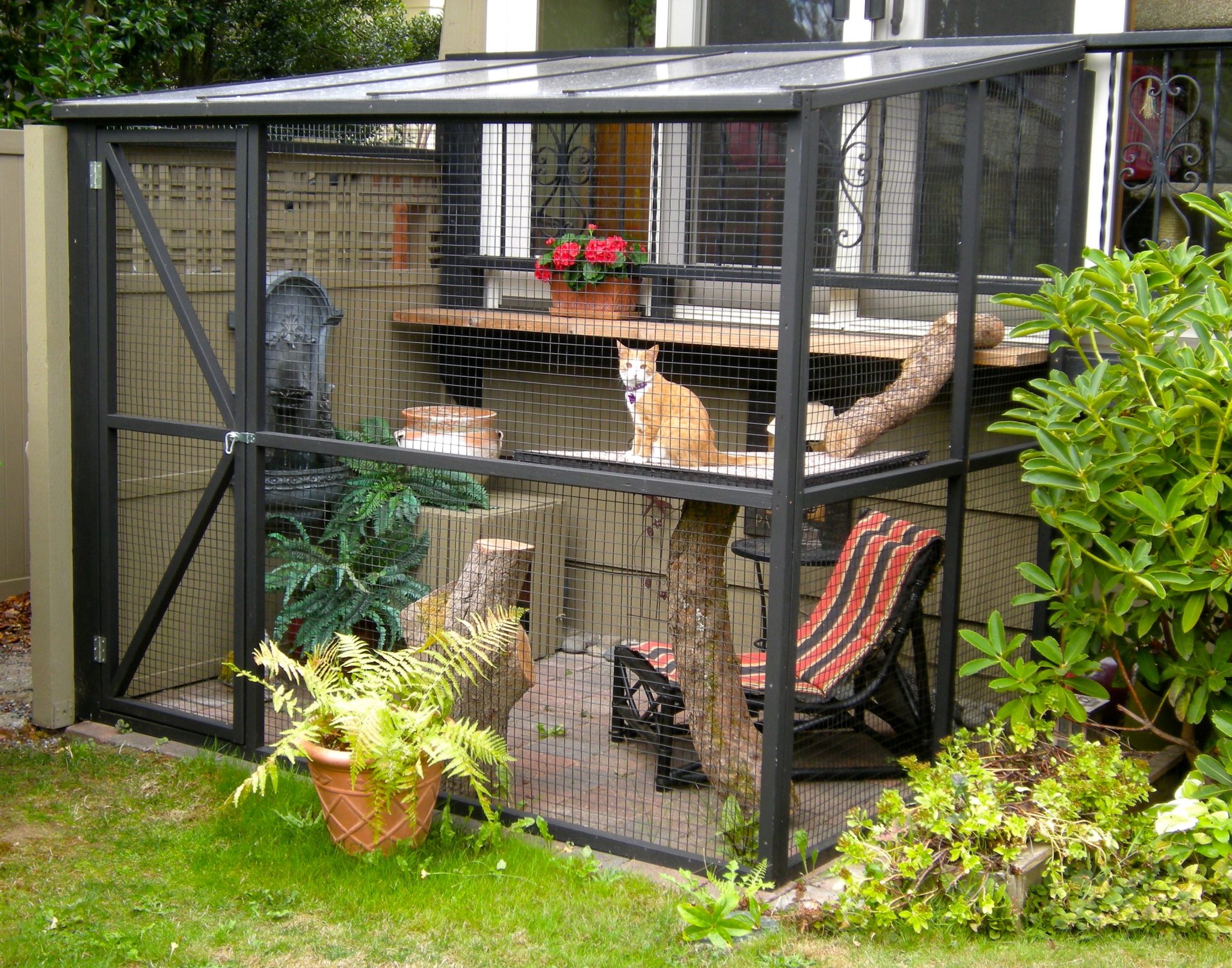
Creating a Purr-fect Paradise: The Ultimate Guide to Cat Patio Enclosures
For cat owners, the desire to provide a safe and stimulating outdoor environment for their feline companions is a common one. A cat patio enclosure, often referred to as a “catio,” offers the ideal solution. These enclosures allow cats to enjoy the fresh air, sunshine, and sights and sounds of the outdoors without the risks associated with roaming freely. This comprehensive guide will explore everything you need to know about cat patio enclosures, from planning and design to construction and enrichment.
Why Build a Cat Patio Enclosure?
Before diving into the specifics, let’s consider the benefits of a cat patio enclosure. These structures address several key concerns for responsible cat owners:
- Safety: Catios prevent cats from escaping and encountering dangers such as cars, predators (dogs, coyotes), and toxins.
- Health: Outdoor access can improve a cat’s mental and physical well-being, reducing boredom and promoting exercise. It also allows for basking in the sun, which aids Vitamin D production.
- Environmental Protection: Keeping cats contained protects local wildlife, such as birds and small mammals, from predation.
- Reduced Indoor Mess: Some cats enjoy using the outdoors as a litter box, which can minimize indoor messes.
- Peace of Mind: Knowing your cat is safe and secure while enjoying the outdoors provides owners with peace of mind.
Planning Your Cat Patio Enclosure
Careful planning is crucial for a successful cat patio enclosure project. Consider these factors during the planning phase:
Location, Location, Location
The location of your cat patio enclosure will significantly impact its design and accessibility. Common locations include:
- Attached to a Window: A simple and cost-effective option, allowing cats to access the enclosure through a window.
- Attached to a Door: Provides easy access for both cats and owners.
- Freestanding: Offers the most flexibility in terms of size and location but requires a dedicated entry point.
- Balcony or Deck: Utilizing existing structures can simplify the construction process.
Size and Dimensions
The size of your cat patio enclosure should be proportional to the number of cats using it and the available space. A larger enclosure allows for more enrichment opportunities and exercise. Consider your cat’s activity level and preferences when determining the dimensions.
Budget Considerations
Cat patio enclosures can range in price from a few hundred dollars for a simple DIY structure to several thousand dollars for a professionally built, elaborate design. Set a realistic budget before starting the project and factor in the cost of materials, tools, and labor (if you’re not building it yourself).
Permits and Regulations
Check with your local homeowner’s association (HOA) and city or county government to determine if any permits or regulations apply to building a cat patio enclosure on your property. Ignoring these requirements could result in fines or the need to dismantle the structure.
Designing Your Cat Patio Enclosure
The design of your cat patio enclosure should prioritize safety, security, and enrichment. Here are some key design elements to consider:
Framing Materials
Common framing materials include:
- Wood: A classic and versatile option, but requires regular maintenance to prevent rot and insect damage. Pressure-treated lumber is recommended.
- Metal: Offers superior strength and durability, but can be more expensive than wood. Aluminum is a lightweight and rust-resistant option.
- PVC: A low-maintenance and affordable option, but may not be as strong as wood or metal.
Enclosure Material
The enclosure material should be strong enough to prevent cats from escaping and withstand the elements. Popular choices include:
- Wire Mesh: A common and affordable option, providing good visibility and ventilation. Choose a mesh with small openings to prevent cats from squeezing through.
- Hardware Cloth: A stronger and more durable option than wire mesh, offering better protection against predators.
- Netting: A lightweight and less expensive option, but not as durable as wire mesh or hardware cloth.
- Clear Panels: Using clear panels (plexiglass or polycarbonate) can provide protection from wind and rain while still allowing your cat to enjoy the view.
Roofing Options
A roof is essential for protecting your cat from the elements. Consider these roofing options:
- Solid Roof: Provides the best protection from rain and sun. Materials include wood, shingles, and metal roofing.
- Shade Cloth: Offers partial shade and ventilation.
- Clear Roofing Panels: Allows sunlight to enter while providing protection from rain.
Entry and Exit Points
Plan how your cat will access the cat patio enclosure. Options include:
- Cat Door: A convenient option for allowing cats to come and go as they please.
- Window Insert: A custom-built insert that fits into a window opening, providing a secure entry point.
- Tunnel: A fun and stimulating way for cats to access the enclosure from inside the house.
Building Your Cat Patio Enclosure
Whether you’re a seasoned DIYer or a novice, building a cat patio enclosure requires careful planning and execution. Here’s a general overview of the construction process:
- Prepare the Site: Clear the area where the enclosure will be located and level the ground.
- Build the Frame: Construct the frame using your chosen materials (wood, metal, or PVC). Ensure the frame is sturdy and square.
- Attach the Enclosure Material: Secure the wire mesh, hardware cloth, or netting to the frame using staples, screws, or zip ties.
- Install the Roofing: Attach the roofing material to the frame, ensuring it is securely fastened and watertight.
- Create Entry and Exit Points: Install the cat door, window insert, or tunnel.
- Secure the Enclosure to the House or Ground: Attach the enclosure to the house or secure it to the ground using anchors or stakes.
Enriching Your Cat Patio Enclosure
A cat patio enclosure is more than just a cage; it’s an outdoor oasis for your feline friend. Enriching the space with stimulating activities and comfortable resting spots will encourage your cat to spend more time outdoors.
Climbing Structures
Cats love to climb and perch. Provide them with opportunities to do so by adding:
- Cat Trees: Multi-tiered structures with platforms and scratching posts.
- Shelves: Wall-mounted shelves that allow cats to climb and explore.
- Ramps: Inclined ramps that connect different levels of the enclosure.
Scratching Posts
Scratching is a natural behavior for cats. Provide them with a variety of scratching posts to protect your furniture.
Plants and Greenery
Adding cat-safe plants to the enclosure can create a more natural and inviting environment. Consider planting:
- Catnip: A favorite among cats, catnip can provide hours of entertainment.
- Cat Grass: A healthy and digestible treat for cats.
- Spider Plants: A safe and attractive houseplant that cats often enjoy.
Comfortable Resting Spots
Provide your cat with comfortable places to relax and nap. Options include:
- Baskets: Soft and cozy baskets lined with blankets.
- Hammocks: Suspended hammocks that provide a comfortable place to lounge.
- Heated Pads: Ideal for colder climates, heated pads provide warmth and comfort.
Toys and Games
Keep your cat entertained with a variety of toys and games. Consider:
- Interactive Toys: Toys that require cats to hunt, chase, and pounce.
- Puzzle Feeders: Toys that dispense food when manipulated, providing mental stimulation.
- Bird Feeders: Placing a bird feeder near the enclosure can provide hours of entertainment for your cat.
Maintaining Your Cat Patio Enclosure
Regular maintenance is essential for keeping your cat patio enclosure safe and functional. Here are some maintenance tips:
- Inspect Regularly: Check the enclosure for any signs of damage, such as holes in the mesh or loose screws.
- Clean Regularly: Remove debris, leaves, and droppings from the enclosure.
- Repair Damage Promptly: Repair any damage as soon as possible to prevent escapes.
- Replace Worn Materials: Replace worn or damaged materials, such as wire mesh or roofing.
Cat Patio Enclosure Ideas and Inspiration
Looking for inspiration for your cat patio enclosure project? Here are some ideas to get you started:
- The Window Box Catio: A small and simple enclosure that attaches to a window.
- The Garden Catio: A larger enclosure that incorporates plants and greenery.
- The Balcony Catio: An enclosure that utilizes an existing balcony or deck.
- The Tunnel Catio: A catio connected to the house via a tunnel.
Conclusion
A cat patio enclosure is a valuable investment for any cat owner who wants to provide their feline companion with a safe and stimulating outdoor environment. By carefully planning, designing, and building your cat patio enclosure, you can create a purr-fect paradise for your cat to enjoy for years to come. Remember to prioritize safety, security, and enrichment to ensure your cat’s well-being. Building a cat patio enclosure is a rewarding project that will benefit both you and your beloved cat. Consider the unique needs of your cat to create a custom space they will truly love. The benefits of a dedicated cat patio enclosure extend beyond just the physical; it strengthens the bond between owner and pet by providing a shared space and enriching experience. So, start planning your cat patio enclosure today and transform your outdoor space into a feline haven! [See also: DIY Cat Furniture Ideas] [See also: How to Train Your Cat to Use a Leash]

